Gigabyte Z77-HD4 Review
by Ian Cutress on May 19, 2013 10:00 AM EST- Posted in
- Motherboards
- Gigabyte
- Z77
Readers of our motherboard review section will have noted the trend in modern motherboards to implement a form of MultiCore Enhancement / Acceleration / Turbo (read our report here) on their motherboards. This does several things – better benchmark results at stock settings (not entirely needed if overclocking is an end-user goal), at the expense of heat and temperature, but also gives in essence an automatic overclock which may be against what the user wants. Our testing methodology is ‘out-of-the-box’, with the latest public BIOS installed and XMP enabled, and thus subject to the whims of this feature. It is ultimately up to the motherboard manufacturer to take this risk – and manufacturers taking risks in the setup is something they do on every product (think C-state settings, USB priority, DPC Latency / monitoring priority, memory subtimings at JEDEC). Processor speed change is part of that risk which is clearly visible, and ultimately if no overclocking is planned, some motherboards will affect how fast that shiny new processor goes and can be an important factor in the purchase.
For reference, the Gigabyte Z77-HD4 does enable MCT when XMP is enabled.
3D Movement Algorithm Test
The algorithms in 3DPM employ both uniform random number generation or normal distribution random number generation, and vary in various amounts of trigonometric operations, conditional statements, generation and rejection, fused operations, etc. The benchmark runs through six algorithms for a specified number of particles and steps, and calculates the speed of each algorithm, then sums them all for a final score. This is an example of a real world situation that a computational scientist may find themselves in, rather than a pure synthetic benchmark. The benchmark is also parallel between particles simulated, and we test the single thread performance as well as the multi-threaded performance.
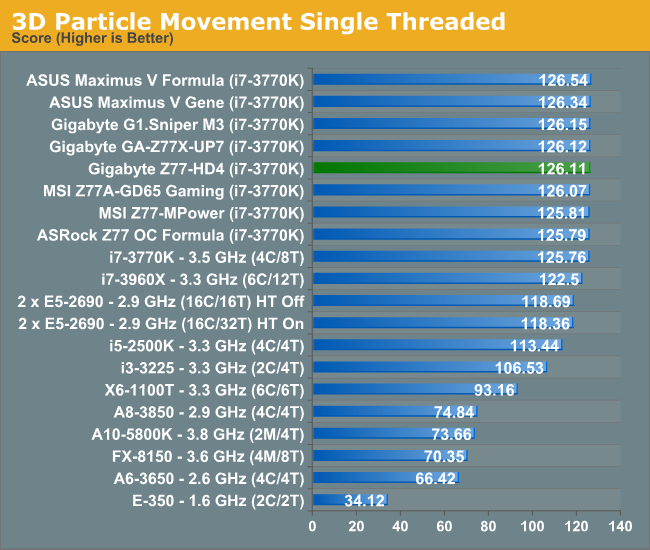
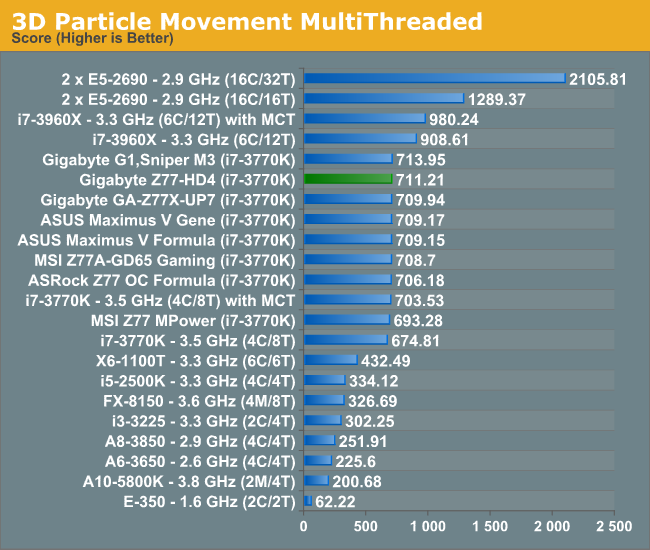
For a $120 motherboard, despite the DPC and Boot Time inefficiencies, the Z77-HD4 deals really well with our 3DPM benchmark, showcasing nice efficiency in multithreaded load. We do not test the memory here, so it provides a contrast result to the poor WinRAR performance below.
WinRAR x64 3.93 - link
With 64-bit WinRAR, we compress the set of files used in the USB speed tests. WinRAR x64 3.93 attempts to use multithreading when possible, and provides as a good test for when a system has variable threaded load. If a system has multiple speeds to invoke at different loading, the switching between those speeds will determine how well the system will do.
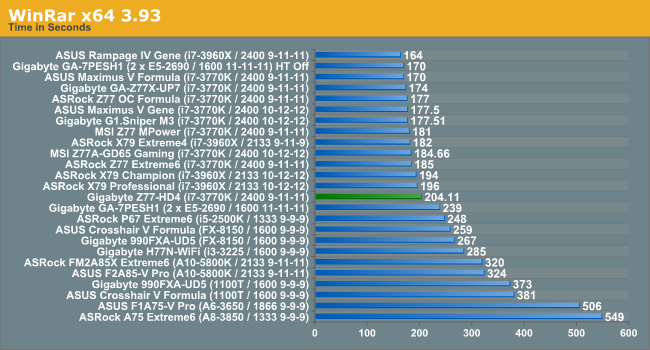
Despite the good 3DPM showing, the WinRAR score comes in as the worst 3770K+ at 2400 C9/C10 we have had. In contrast, for our new WinRAR 4.2 testing, the Z77-HD4 scored 54.36 seconds.
FastStone Image Viewer 4.2 - link
FastStone Image Viewer is a free piece of software I have been using for quite a few years now. It allows quick viewing of flat images, as well as resizing, changing color depth, adding simple text or simple filters. It also has a bulk image conversion tool, which we use here. The software currently operates only in single-thread mode, which should change in later versions of the software. For this test, we convert a series of 170 files, of various resolutions, dimensions and types (of a total size of 163MB), all to the .gif format of 640x480 dimensions.

Xilisoft Video Converter
With XVC, users can convert any type of normal video to any compatible format for smartphones, tablets and other devices. By default, it uses all available threads on the system, and in the presence of appropriate graphics cards, can utilize CUDA for NVIDIA GPUs as well as AMD APP for AMD GPUs. For this test, we use a set of 32 HD videos, each lasting 30 seconds, and convert them from 1080p to an iPod H.264 video format using just the CPU. The time taken to convert these videos gives us our result.
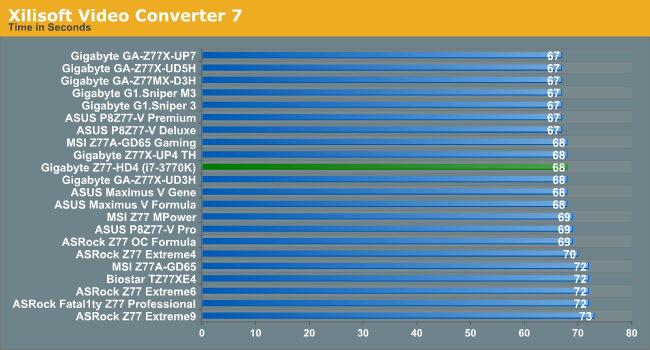
x264 HD Benchmark
The x264 HD Benchmark uses a common HD encoding tool to process an HD MPEG2 source at 1280x720 at 3963 Kbps. This test represents a standardized result which can be compared across other reviews, and is dependent on both CPU power and memory speed. The benchmark performs a 2-pass encode, and the results shown are the average of each pass performed four times.
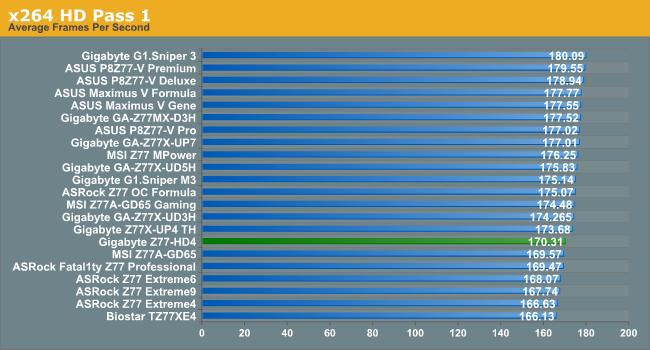
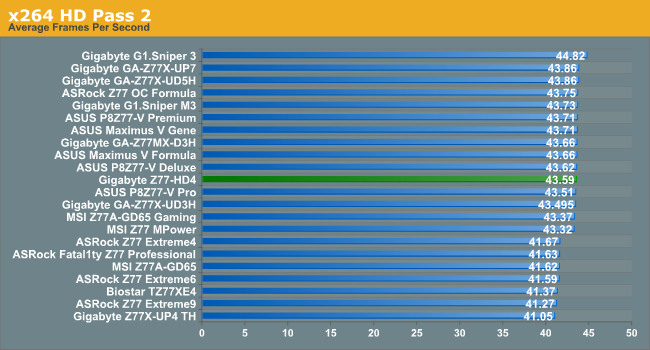










63 Comments
View All Comments
lever_age - Sunday, May 19, 2013 - link
I also agree that a greater emphasis should be placed on these cheaper options. It's not always easy to be able to tell when too many corners have been cut.Particularly with power consumption going down the way it has, all the companies are rather overselling VRMs for overclocking. For a moderate 24/7 overclock on air, enough to satisfy say a gamer wanting to grind something out of the SC2 engine or somebody wanting to speed up some calculations, where's the cutoff point of quality in how low you can reasonably go? (Yeah, more phases and higher switching frequency can mean lower ripple, and lower temps and power losses are better, but how much of a big difference does that really make?) Of course, it's still hard to tell about longevity.
klmccaughey - Sunday, May 19, 2013 - link
Been using Gigabyte boards for ten years now almost exclusively. They're always good with decent overclock options. Never had a bad one yet.Wall Street - Sunday, May 19, 2013 - link
I feel like Ian is stretching when he critiques this board for not having onboard power/reset buttons and error code displays. I guess he assembles and disassembles systems all day long, but having these features on my current motherboard, I never use them (I only have them because I needed to replace my 1156 board and only high-end parts are still readily available when I ordered).I guess he has finally seen the light when it comes to overclocking though. The motherboard makers stretch as much as they can to justify the extra $50=$100 to up-sell enthusiasts. However, Intel has done an incredible job designing their chipsets and most users don't need 8+ SATA, 12+ power phases, or debug codes, and few use SLI/Crossfire.
Wall Street - Sunday, May 19, 2013 - link
And I forgot to mention "this board is probably aimed at the internet café market in China" is pretty shameful and below the belt Ian. As you have shown yourself, it is just as good at gaming as the $200+ boards unless extreme overclocking or multi-GPU. Go look at a Steam survey to see what actual gamers have installed - this board is quite capable of power a system in the top 1% of Steam users.A5 - Sunday, May 19, 2013 - link
Seriously. There are so few use cases that justify the $200+ boards.I know the $300 boards are more fun to review, but I think AT users are better served with reviews of these sub-$150 Z-series boards.
ForstAmt - Sunday, May 19, 2013 - link
What those guy said.I honestly don't know what the point of this review is. So having a HE GPU running in a PCIe x4 slot is not a good idea. Really? Well I don't think that in 2013 anyone needed a review to know that. Seems like that is the main focus of the review though.
For most people running PCs on hardware aimed at chinese internet cafes it would probably be much more interesting how well thought trough the layout is.
Are the fan connectors positioned in a way that makes sense? How about the slot layout: Can you use a graphics card (2 or 3slot) along with 2 or 3 other pci and/or pcie cards without problems? (and no, i am not talking about another gpu -.-).
But atleast the reviewer was honest at the beginning when he stated that he doesn't have a clue. And it shows. I really like anandtech but this review aggravated me enough to register and comment.
p.s.: I hope my chinese internet cafe hardware manages to send this comment in a way that makes it readable on you guys using the regular sniperelite and rog gaming elite stuff.
ForstAmt - Sunday, May 19, 2013 - link
Please excuse the typos.kmmatney - Sunday, May 19, 2013 - link
Well - the review was useful for me. These are the types of boards I buy, and I might have missed the fact that it uses a 4x slot for the second card. I effectively spent $59 for my My GA-Z77X-UD3H, but didn't think to look at what happens when you run 2 GPUs. Thankfully my board runs them at 8x/8x, which gives better performance, but I hadn't thought to even check that when I bought it. Not that I've ever used 2 GPUs...jonjonjonj - Wednesday, May 22, 2013 - link
why the techpowerup article only shows a 5% difference between 3.0 x16 and 2.0 x4 with a 7970. terrible crossfire drivers?http://www.techpowerup.com/reviews/Intel/Ivy_Bridg...
Jambe - Sunday, May 19, 2013 - link
I agree but I'd also like to see reviews of boards with other chipsets, namely Z75 and H77.